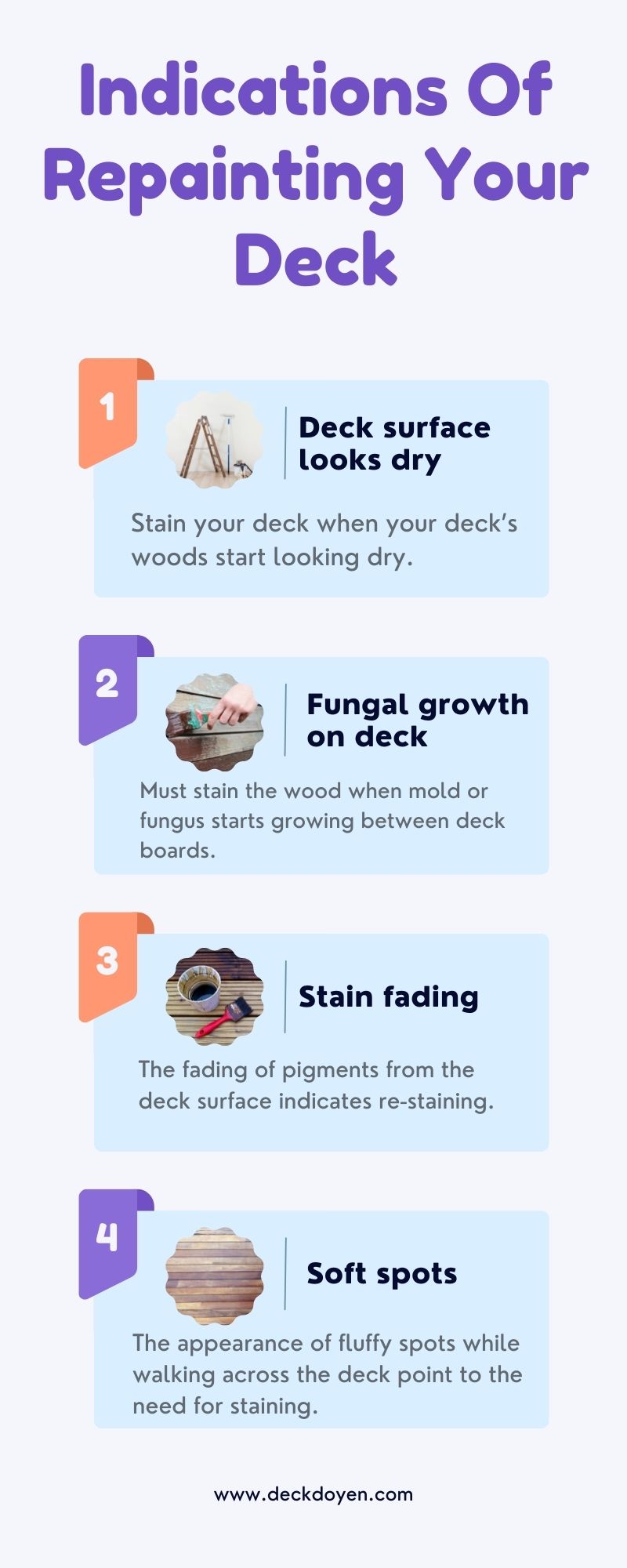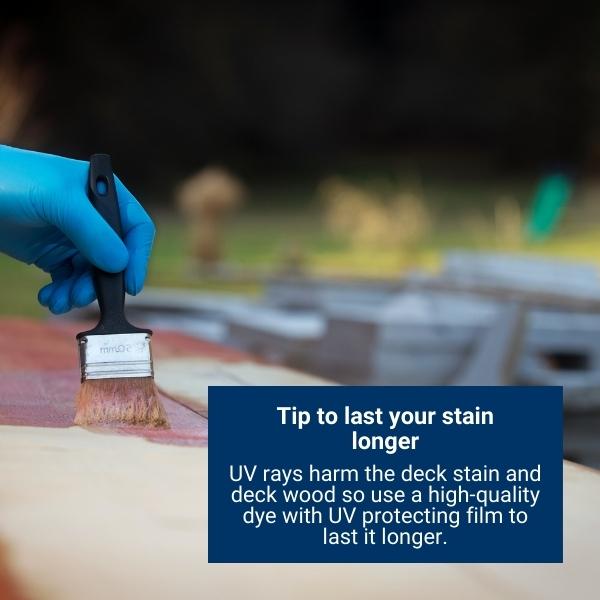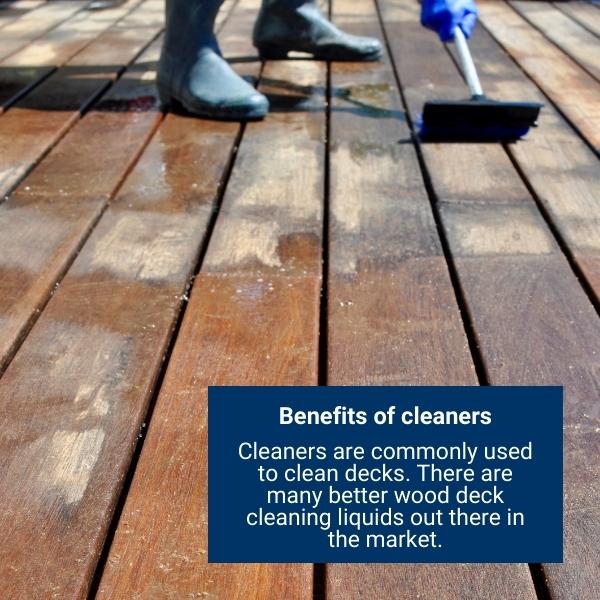After spending a lot of money on the new deck construction, you might want to know everything about conserving it from destruction. Staining a deck is the best way to keep your deck surface fresh. Does this question bother you about how often you should dye your deck surface to increase the life of your deck? The answer to this question is simple but tricky.
Some decks require staining soon after the construction to keep them fresh. However, a pressure-treated deck needs staining after 18 to 19 months. Retaining the deck depends on the quality of the deck paint you have used to cover it. Usually, an average deck should refinish after every 2-3 years Or when your old paint starts deteriorating.
For better results and beautiful and aesthetic staining, you need to understand the perfect ways of staining and the time gap between two stainings. That’s why I have authored everything you need to know about maintaining your deck perfectly. So, look at this article to perceive more about deck staining.
When To Restain Your Deck?
Staining not only helps you out in making your deck look great but also increases the life of your deck. If you pay a little attention to your deck, you can see clear signs that your deck needs refinishing. The gap between two stainings depends on different factors, such as the material you used in deck construction, the condition of the material, and when it was last stained. For your complete assistance, I penned down these signs too.

Dry Deck Surface:
The dryness and flaking of the deck surface is the sign that your deck needs staining. If your wooden floor feels dry when you walk on it, you should paint it. It means that all the absorbed oil of wooden planks has been evaporating, and your deck needs replenishing.
Unwanted Organism Growth:
Fungal, moss, algae, and mildew maturation are dangerous to your deck. It destroys the wood from the inside and can cause cracking of wood planks. So whenever you notice an unwanted organism growth between the spaces of deck boards, you must stain your wooden floor immediately.
Fading Of Pigmentation:
Decks surfaces face extreme weather conditions, sunlight, UV rays, and humidity every time. These conditions affect the level of pigmentation on your deck surface and start fading. So, if you observe that your stain is fading away, stain it again to keep it new. Besides, faded pigments are not visually appealing. Hence, it would be best to dye your deck as soon as the previous stain begins to fade.
Presence Of Soft Spots On Wooden Floor:
Your deck surface should not feel uneven and soft when you walk barefoot on it. It is supposed to feel tough and has fine finishing. So, if the deck wood felt soft in some areas, you must understand your deck’s need for restaining. Softening of food is a sign of damage and needs immediate action.
Also Read: Should A Deck Be Level Or Sloped? Detailed Answer!
When To Stain Your New Deck?
New wooden decks should always need painting and staining. All new decks should cure for at least 30 days before staining or painting. Although you can apply a finish immediately upon installation, it requires more labor, so it’s preferable to let the wood dry completely before finishing. These are basic recommendations; the timescale will vary depending on your climate; for example, wood in a dry, arid region will cure faster than wood in damp, humid weather.

Pressure-Treated Wood
Allow at least six months for pressure-treated timber to cure before applying stain or any other wood treatment. Pouring water on the boards is an excellent test. It’s still too moist if it beads up. If the water soaks in, the surface is ready for staining.
Kiln-Dried Wood
The majority of the timber sold in hardwood stores is kiln-dried. Allow at least one to two months for this wood to cure before staining or painting.
Greenwood
Greenwood refers to recently cut wood. Green treated lumber, which is wood that has had an anti-rot treatment, should not be mistaken for this type of wood. Due to its accessibility, some people continue to use it even though it’s not the finest material to work with because it can bend and break as it dries. Green timber should be allowed to cure for at least one year per inch of thickness and preferably longer.
Also Read: Deck VS Terrace: Difference Explained!
How Long Does Deck Stain Last:
The life of a stain depends on several things like the number of sun rays, the condition of your wood, and application methods. Moreover, efficient maintenance will keep your deck better for long periods. You will also need to pay attention to the deck top to determine the need for replenishing. The best stains last 2-4 years if applied efficiently. The sun rays, rain and snow, dirt, and grime settled on its surface, so it is essential to maintain your deck with a quality stain.

How To Spray-Paint Your Deck:
Generally, there are many different methods to spray stains on your deck. These several methods give you a free hand to select any of them which is convenient for you. Opt for the most efficient method, which is by using a low-pressure pump sprayer. It provides excellent results and is also easy to use. Using a pump spraying tool, you can stain your deck handily within a few hours.
What Temperature Is Suitable To Stain, And How Much Time Does The Stain Take To Dry?
If you have decided to stain your wooden floor, you must consider the weather and time of day for selecting the staining. For staining, you have to consider climate and humidity both, as they affect the period of how long your stain will dry outside. In dryer or warmer conditions, the drying time of the deck paint will be shorter. The more humidity will cause more time for the deck dye to dry outdoors. Interior stains take around 6-24 hours to dry, while exterior paints take 24-72 hours.
Pre-Staining Steps:
Here are some of the ways to prepare your deck before Staining:
Also Read: Can You Install Trex Decking In The Winter? A Definitive Guide!
Clean The Deck Before Staining
All you need is to remove dirt from your deck. Then use any deck cleaner and apply it to your entire deck using a roller or pump sprayer. Take safety precautions, don’t forget to wear a face mask, gloves, and eyeglasses to avoid contact with the cleaner with your skin. Make sure to cover the entire surface of the deck with the cleaner. Wait 15 minutes to give your cleaner enough time to soak into the wood. The next step is to use a stiff brush to remove all grime. For this, a power washer works efficiently. Must keep the psi between 1200-1400 so that it doesn’t cause any damage to the deck. You must maintain a distance of at least 8-12 inches from the wooden floor. Apply sand to remove the remaining residue when the deck gets completely dry. Now the deck is ready for the stain.
Preparation Of Power Wash
Before power cleaning the decking, remove the existing stain. It ensures that the fresh stain layer adheres correctly to the wood and extends the life of your deck. Then apply a deck stain remover to the surface to break up the old stain and prepare it for pressure cleaning. Lastly, use a deck brightener. It will raise the pH of the wood and open up closed and dried grains, allowing the stain to penetrate and connect with the grain.
Steps To Do The Power Wash
After using a deck stain remover and brightener, you may begin pressure cleaning. Use the minimal pressure possible to avoid damaging the wood. Although, you may clean the deck with water. Some individuals like to use a light cleaning agent. So If you opt to use one, ensure there are no puddles on the surface since this may harm or discolor the timber. Let the deck dry completely.

Steps Of Restaining Deck With Similar Color:
It was the guide to preparing the deck for staining with a non-similar paint or brand. However, you can follow the steps below to restrain your board again with the same color and brand.
- To remove dust from the deck, use a pressure washer and an all-purpose deck cleaner containing a light detergent to wash and rinse the surface. Dust hinders adhesion.
- If your deck has faded and grayed, use a brightened decking or restorative cleanser to clean it.
- If your deck has mold or mildew, you should clean it using a mildewcide cleaner.
- When using a cleaning chemical or stripping, always follow the recommendations on the label.
- Wear your protection equipment regardless of the product.
- Spread the cleanser using a natural-bristle paintbrush or a hose with an applicator clip.
- Apply the cleanser by proceeding from one side of the surface to the other and scrubbing in a single direction. The goal is to get a clean naked wood surface rather than removing the layer of the previous stain.
- Use a cloth to compress or wipe any puddles that appear.
- Allow the deck to cure for 24 to 48 hours before applying the fresh stain to the smooth surface.
Also Read: Are Decking Screws Rust Proof? A Definitive Guide!

What Is The Benefit Of Maintaining Deck Stain?
For long-lasting beautiful stains, you need to follow regular maintenance. This approach saves you from repairs and early-restained issues. You can keep care of your deck with a proper maintenance schedule. Firstly you need to clean your deck by sweeping it to get rid of dirt. You can hose it once in six months if necessary. Always keep an eye on soft spots, fade the deck shade, or cracks on the deck. Don’t go for pressure cleaning often because it can affect your deck’s stain.
How Much Stain Does An Average-Size Deck Need?
The stain you need depends upon the size of your deck. The bigger the deck is, the more deck dye you will need for the refinishing. An average of 175 square feet of decks need not more than one gallon of paint. If the size of your deck is about 500 square feet, you need two gallons of stain to ensure you don’t run short of color while maintaining it.
What Is The Average Cost Of Staining A Deck:
Like all things, the deck needs maintenance and staining to improve its appearance and life. For this, you must consider your deck size, conditions, and cost of the product you are using for stain. Moreover, many quality paints are available in the market. Make sure you only use a high-quality product for your deck that may cost you between $2.00-$4.00 a square foot to stain.
Conclusion:
Deck staining or maintenance may appear to be a simple weekend project, but it may be more intricate and time-consuming than you think. Although staining a deck may be completed in a few days, it requires seamless cleaning, drying, and coating techniques to produce a smooth, uniform finish. It ensures that the stain will endure and that you will not have to restain the deck within a year. Don’t take shortcuts or speed up the preparation because the duration between two stainings depends on all these factors. The better you stain, the more durable your stain will be. So, follow all instructions, stain properly, and look for signs that indicate staining.
Also Read: How To Lay Decking On Grass? Step By Step Guide!
FAQs
How Is Deck Painting A Better Way To Maintain Your Deck?
When refinishing your deck, both stain and paint will help protect it from moisture and weather-related damage. However, both differ in appearance, durability, application, maintenance, and cost. As compared to the other two, the stain is more budget-friendly.
What Are The Benefits Of Staining A Deck?
Staining enhances the appearance of your deck. It prevents the deck from moisture absorption. It also protects the deck from the sun exposure that causes discoloration of your deck. Moreover, to other maintaining methods, staining is effortless and wallet-friendly too.
How Can Bleaching And Chemicals Harm Your Deck Wood?
Chemicals can weaken the wood and cause the deterioration of some deck floors. That’s why experts suggest not to bleach your deck. It will fade the pigments on the surface. Hence, bleach is not a great wood cleaner. It damages the wood fibers and is unsafe to handle. So, ensure you don’t use harmful chemicals and bleach on deck.

